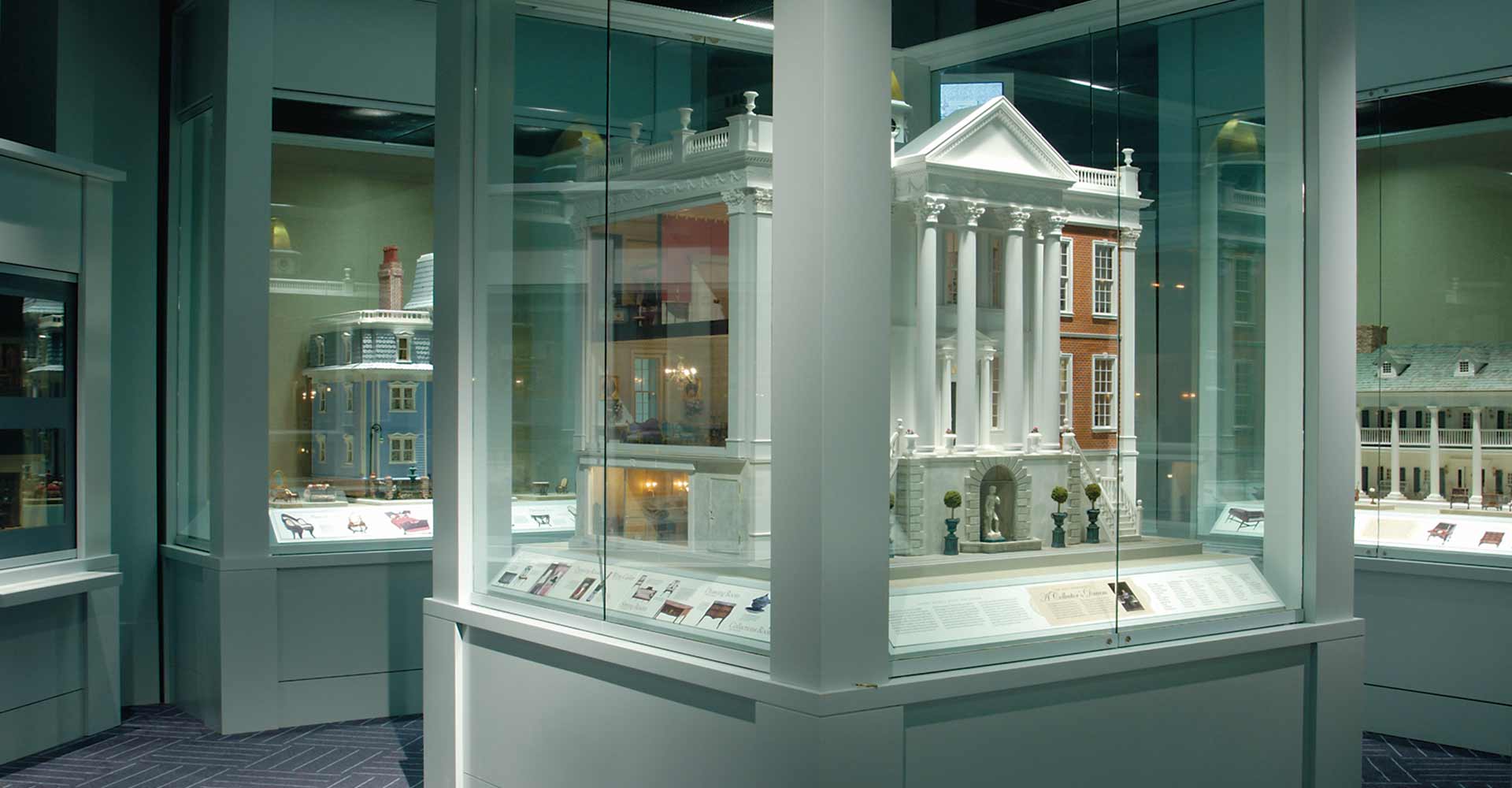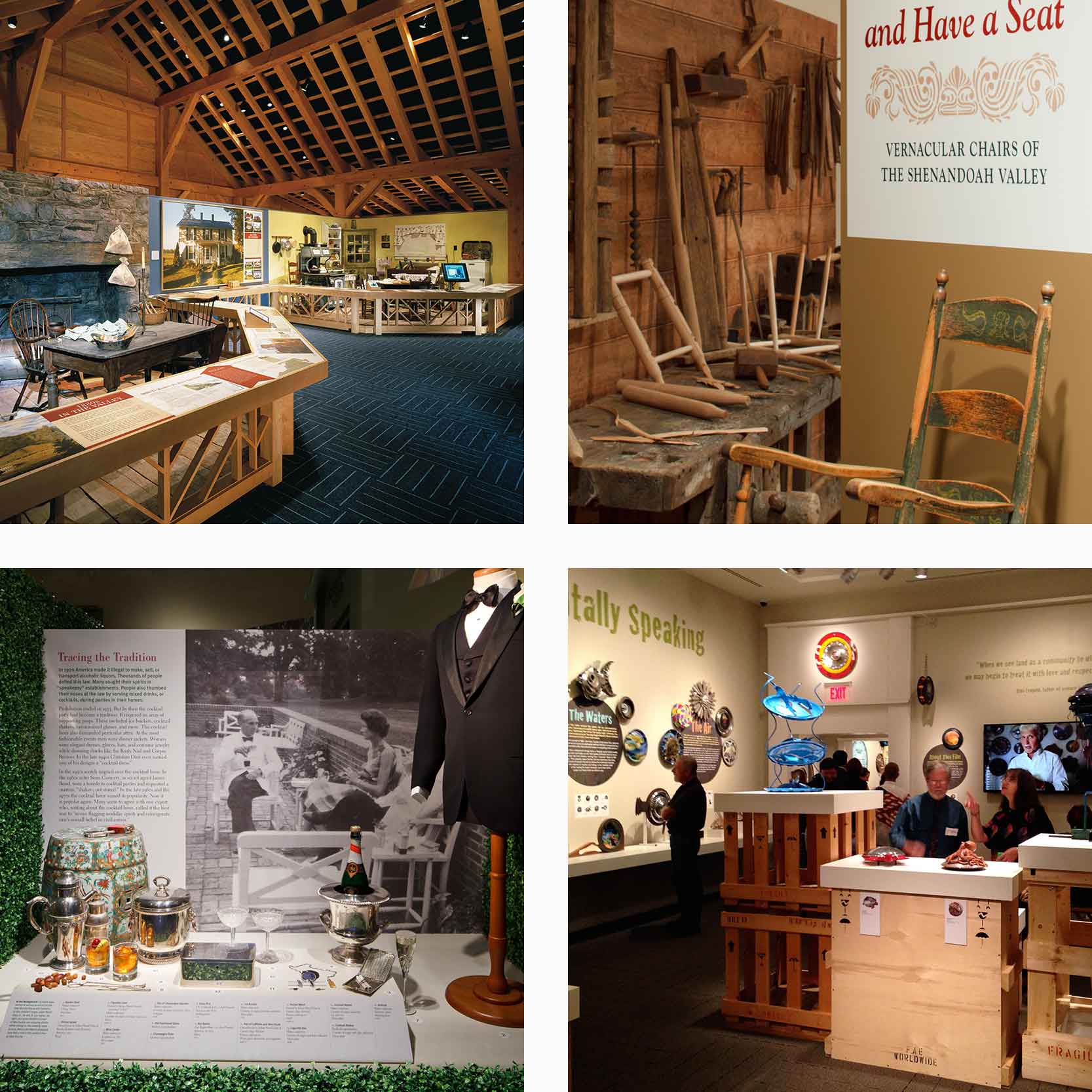Museum of the Shenandoah Valley
Winchester, Virginia
The Museum of the Shenandoah Valley interprets the art, history, and culture of the great valley for which it is named. This regional museum complex in Winchester, Virginia, includes a historic house dating to the eighteenth century, six acres of spectacular gardens, and a museum building designed by internationally recognized architect Michael Graves. For more information, visit www.shenandoahmuseum.org.
In the original installation, 1717 designed a combination of diorama vignettes, rich graphics, and high‐tech multi‐media stations for The Shenandoah Valley Gallery to provide a comprehensive look at how people settled in the Valley — struggled for its lands — were sustained by its bounty — and became part of the eventual merging of its cultures. The adjoining Decorative Arts Galleries were designed to explore the aesthetic values that characterize the objects found in Valley homes since the 1700s. When the Museum opened, the Julian Wood Glass Jr. Gallery displayed the benefactor's 18th‐ and 19th‐century European art and decorative arts collections. The R. Lee Taylor Miniatures Gallery, showcasing a phenomenal collection of miniature houses, features the work of seventy artists, many of whom are giants of the diminutive world of miniatures.
Since the museum opened, 1717 Design has been invited to design several changing exhibits in what is now called the Founder's Gallery as well as assist them renovate the larger Julian Wood Glass Jr. Gallery and convert it for use as the new Changing Exhibitions Gallery where they can now host more extensive temporary exhibits.
Jed Hotchkiss, Shenandoah Valley Mapmaker
Gen. Stonewall Jackson's chief cartographer during the Civil War, Jedediah Hotchkiss, would often work on horseback in the field, observing and drawing the lay of the land. Of the 50 facsimile maps and sketches on display, 48 come from the renowned Hotchkiss Map Collection in the Geography and Map Division at the Library of Congress. Included in this traveling exhibition created by the Museum of the Shenandoah Valley is the “Great Map of the Shenandoah Valley 1862–65.” Hotchkiss created this map, considered a masterpiece, after General Stonewall Jackson summoned him to “prepare a map showing all points of offense and defense in the Shenandoah Valley from the Potomac to Lexington.” The map measures 7.5 feet by 3 feet. Juxtaposed on the wall is “Satellite Image of the Shenandoah Valley (ca. 2000),” which covers the same area as the Hotchkiss map, offering an interesting 21st-century comparison.
Come In and Have a Seat: Vernacular Chairs of the Shenandoah Valley
By 1800, the Shenandoah Valley was home to many craftsmen of German, Swiss, English, Irish, and Scottish descent. Using familiar European craft traditions, these craftsmen made durable and comfortable chairs, but they were also influenced by fashionable designs from cities like Philadelphia and Baltimore. Assembled with 43 chairs on loan from nine different private collections, most of which had never been on public display, Come In and Have a Seat was the first exhibition devoted to the study of nineteenth‐century Shenandoah Valley vernacular chairs. The exhibition also included the most exuberantly decorated early Valley chair that is known to exist. Interactive elements incorporated into the display included reproduction Shenandoah Valley chairs where visitors could “have a seat,” large‐scale chair puzzles, and a re‐creation of an 1850s chair shop — featuring authentic tools and furnishings from the Adam Kersh Shop of Augusta County, Virginia.
Moveable Feasts: Entertaining at Glen Burnie
Moveable Feasts, the Museum's first exhibition to focus on the extensive entertaining that took place at the Glen Burnie House and Gardens in the 1960s. The light‐hearted exhibition takes visitors on a stroll through a garden maze to glimpse vignettes of the various “moveable feasts” — brunch, afternoon tea, cocktails, and dinner — that MSV benefactor Julian Wood Glass Jr. (1910–1992) and his partner at the time, R. Lee Taylor (1924–2000), hosted at the site. Along with providing an engaging glimpse at Glass's and Taylor's life at Glen Burnie in the 1960s, the exhibition also details their entertaining traditions and includes more than 100 objects from the house and gardens. To transport visitors back in time to Glen Burnie as guests of Julian Wood Glass Jr. and then partner R. Lee Taylor, 1717 transformed the gallery into an intimate garden environment. Faux boxwood hedges were used to create a series of isolated vignettes that recreate and interpret the unique experience associated with each meal.
Second Time Around: The Hubcap as Art
An exhibition of environmentally inspired contemporary art, Second Time Around: The Hubcap as Art presents the work of 287 professional artists and art educators from around the world. Each artist whose work is included in the exhibition had accepted a challenge, issued by the nonprofit Landfillart Project, Wilkes‐Barre, Pennsylvania, to make art out of a discarded hubcap or hubcaps. The artworks are from every U.S. state and 35 other countries. An immersive experience, Second Time Around surrounds the visitor with colorful objects ranging from those that make social commentaries to others that cause visitors to laugh out loud. Objects are stacked high on walls or hang suspended from them, with numerous sculptures presented on pedestals made of materials reused from the museum's previous projects. Several objects illuminate or are kinetic, and two were designed to be solar‐powered.
Also see the Museum of the Shenandoah Valley's book designed by 1717.

